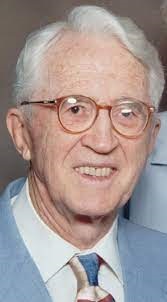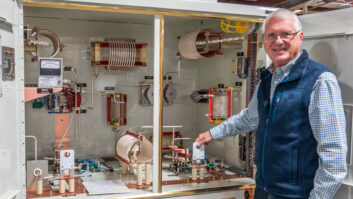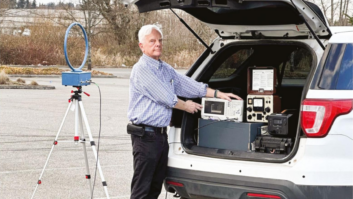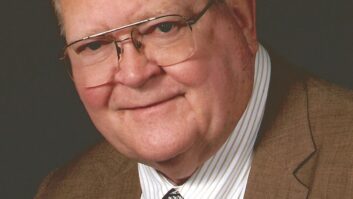
The sheer number of Kintronic Laboratories’ phasors and tuning units in use all over the world are testimony to the impact Louis King has had on the radio broadcast industry, those who know him say.
Peers describe him as an inventor, educator, consulting engineer and successful businessman. He taught electrical engineering at the former Clemson College in the 1940s and later helped design the first air-cooled 50 kW AM transmitter while working at RCA.
In addition, King received the patent for the bistable multivibrator, the “flip-flop circuit” used as a switching device in early computers.
King, 92, founder of Kintronic Labs, is the recipient of this year’s NAB Radio Engineering Achievement Award.
Hard Projects
Ron Rackley, vice president of consulting engineering firm du Treil, Lundin & Rackley, cites King’s confidence in doing unusual projects and his willingness to innovate.
King “was not afraid to take on projects that you might have a hard time finding anyone else to do. He took on projects that were outside the comfort zones of many other people doing similar work,” Rackley said. “Louis was the first to start the now popular trend of designing phasors without conventional power divider circuits and with low-Q unequal-resistance networks of different types.”
Rackley said he began his career working as an antenna designer at Kintronic Labs nearly 30 years ago working under the tutelage of Louis King.
“I recall fondly many late nights and weekends spent with Louis trying to figure out a customer’s problem. He was very good about customizing a solution to fit the circumstance,” Rackley added.
King was from the pre-computer modeling era “when engineers designed things using calculations … then built them to see what they would do.” Rackley said King had insights and intuition like few engineers he’s known.
Lynn Claudy, senior vice president of NAB Science and Technology, said, “Louis has mentored many professionals in the broadcast engineering field and did a lot of work for broadcast engineer education. His contributions to the field have been considerable.”
Kintronic Labs has become a leader in the design and manufacture of components and systems for the broadcast industry under Louis King, said Tom Silliman, president and CEO of Electronics Research, Inc.
“Kintronic has become a leading supplier of medium-wave broadcast antenna systems worldwide. This is very largely attributable to the guiding influence of Louis. He has dedicated himself to the success of his company and the radio industry for over a half a century,” Silliman wrote in his nomination of King for this year’s award.
‘Practical Perfection’
Jack Sellmeyer, president of Sellmeyer Engineering, said he has known King for more than 35 years and watched as Kintronic Labs helped advance the state of terrestrial AM broadcasting.
“Louis placed an emphasis on practical perfection, which he instilled in his employees.”
King began his study of electrical engineering following the Depression at the University of Tennessee and gained his first patent for a unique pulse transformer design while a graduate student at the University of Missouri. He later taught electrical engineering at Clemson College, now called Clemson University, where he developed the Radio Engineering curriculum.
It was at the Radio Corporation of America that King, while working as a high-power transmitter design engineer, patented the bistable multivibrator, which was used in the grid circuit design for the power tube used in the first air-cooled 50 kW broadcast transmitter. The “flip-flop” circuit constituted the basic switching logic device for the earliest digital computers later developed by RCA.
King also developed an RF drying process for the Goodyear Tire and Rubber Company while at RCA, one that allowed for a foam rubber production plant to yield a consistent quarter-inch thickness used for cushions.
Despite successes at RCA, King left in 1949 and returned to his native Tennessee to launch his own broadcasting engineering consulting firm, known as Louis A. King Consulting Engineers. By 1952, King began producing isocouplers and AM antenna equipment.
During the 1950s King designed custom antenna systems for numerous transmitter manufacturers, such as Singer, McMartin, CCA, ITA, Wilkinson, CSI, Elcom-Bauer and Collins Radio.
“Louis was innovative as anyone in both RF system design and RF component design, creating many custom RF components and inductors to make them easier to use,” Silliman said.
King named his manufacturing enterprise Kintronic Laboratories Inc. and discontinued his consulting business in 1962. Kintronic, based in Bluff City, Tenn., has several dozen employees and is run by Louis King’s son, Tom, who is president. Louis King’s daughter, Gwen, is vice president.
“My father never turned down a technical challenge. You just had to tell him what you wanted and he would build it for you,” said Tom King, who took over the presidency in 1993.
Louis King, still chairman of Kintronic Laboratories, lives in Bristol, Va.







